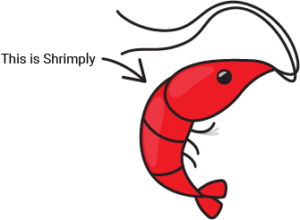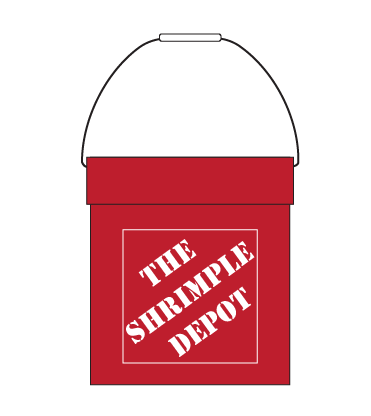Shrimply Explained is currently undergoing renovations. Please don't buy anything yet. Thank you!
You and your shrimp deserve the best and Shrimply ExplainedTM is here to provide that. This lesson is part of our Shrimp Basics (SB) Series, which covers important information needed to raise healthy and happy shrimp. Check out SB101: Are Shrimp Right for You? if you want to start from the beginning.
Please reach out to us via social media or email for any help with your tank, feedback on our content, or just to talk about shrimp!
Sincerely,
Rick and Shrimply

Shrimply Explained™ is a participant in the Amazon Services LLC Associates Program, an affiliate advertising program designed to provide a means for sites to earn advertising fees by advertising and linking to Amazon.com.
To prepare for our patient’s arrival, we need a reasonably-sized tank or container – the bigger the better since more water leads to a more stable environment but realistically anywhere from 1-10g (4-38L) will work. A bucket or large food container works as well as a glass aquarium for a quarantine tank, although clear sides are nice to be able to see your shrimp patient at any angle.
As with any tank, always clean it up before use with vinegar OR hydrogen peroxide, then rinsing with hot water (mixing cleaning agents can be dangerous – vinegar and hydrogen peroxide becomes corrosive and vinegar and bleach creates chlorine gas).
Note: As your animal may be stressed during quarantine/treatment, it is a very good idea to cover the top of the quarantine tank so it cannot escape. Shrimp have been known to climb out of tanks occasionally.

If possible, RO/DI (or spring) water remineralized to the same GH and KH is the best option. We recommend freshly remineralized water over water from your main tank because purified water is more controlled to ensure healthy conditions. The water in your main tank may even be part of what is making your shrimp sick and we want to eliminate any potential problems. If you cannot get RO/DI water, then we recommend fresh tap water matching the parameters in your main tank (don’t forget to dechlorinate it!).
Our goal with a quarantine tank is to maintain the healthiest conditions possible, which means we need to oxygenate it and take care of waste. A single shrimp has a very low bioload so a simple airstone in a small quarantine tank is often enough. For larger tanks (>5g) or those with more than 1-2 shrimp per gallon, a pre-cycled filter is recommended to eliminate ammonia and increase water agitation/flow.
Situations where you need a quarantine tank often don’t allow for the week or so it takes to cycle a filter though. If you don’t have a pre-cycled filter, just stay on top of water testing and do water changes if ammonia/nitrites/nitrates build up.
Botanicals like Indian almond leaves and alder cones release tannins into the water, which have been shown to improve immune function in shrimp and other animals. We recommend quickly boiling your botanicals for 2-3 minutes to remove any pesticides/contaminants on them. This does remove some of the tannins but is best to avoid potential issues. Once botanicals are added to the quarantine tank, you should see the water take on a brown tint, indicating tannins are being released into the water.
About 2-3 botanical pieces per gallon should be enough. Adding too many botanicals can cause your pH to drop outside of the recommended range of your shrimp. Here's a good deal on indian almond leaves if you'd like to buy them from Amazon. There are cheaper sellers on Ebay if you're interested in buying larger quantities
That’s everything you need for a quarantine tank for shrimp!

The next step is to treat your shrimp, which typically involves salt dips or hydrogen peroxide dosing. You can find more about these treatments by following the links below:
SB 109.1: Treating Shrimp With Salt Dips
SB 109.2: Treating Shrimp With Hydrogen Peroxide